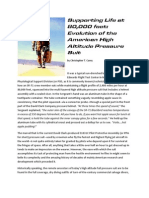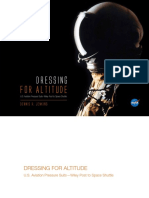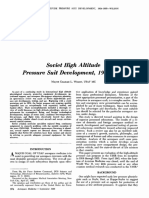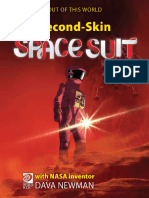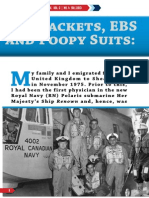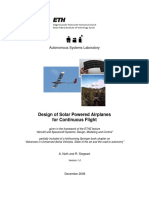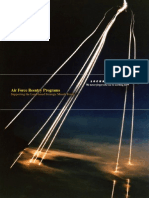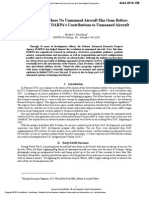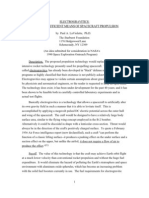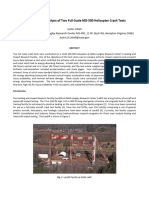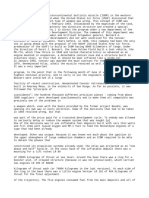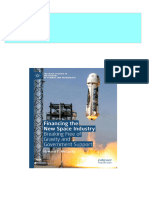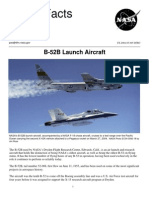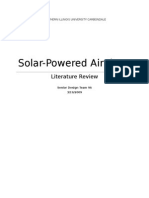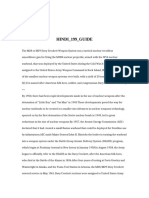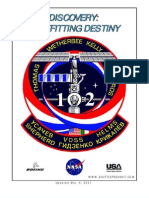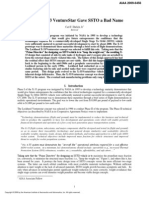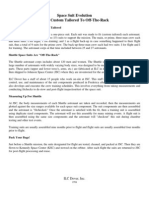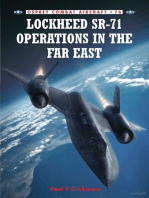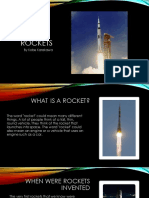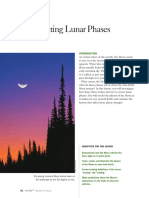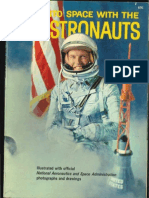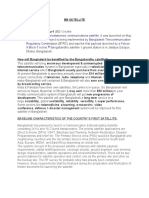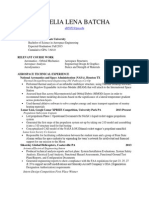Mauch
Mauch
Uploaded by
Sidney CarterCopyright:
Available Formats
Mauch
Mauch
Uploaded by
Sidney CarterOriginal Description:
Copyright
Available Formats
Share this document
Did you find this document useful?
Is this content inappropriate?
Copyright:
Available Formats
Mauch
Mauch
Uploaded by
Sidney CarterCopyright:
Available Formats
Sec. 8.
2]
8.2 Early USAF spacesuit developments (195964) 175
Figure 8.1.2. DCC X-20 ``Dyna-Soar'' suit congurations.
(Courtesy, left and right, Hamilton Sundstrand and G.L. Harris)
8.2
EARLY USAF SPACESUIT DEVELOPMENTS (195964)
The USAF's foray into spacesuits was not limited to specic program applications. The USAF funded two interesting eorts in its rst years in the eld. One was a unique approach to a mechanical counterpressure suit that was concepted and executed by Mauch Laboratories of Ohio. The other was the David Clark Company's implementation of USAF concepts for an extravehicular suit system. In 1959, the USAF funded Mauch to explore the idea of using a passive approach to mechanical counterpressure rather than the ``active'' method used in the David Clark capstan-tube ``partial pressure'' that was used in defense applications and the X-1 record attempts. Like the David Clark system, the head and lungs were provided with pressurized oxygen while a garment tightened on the torso, arms and legs to provide a closely matching external counterpressure. This Mauch suit (Figure 8.2.1) utilized the dynamics of closed cell foam, which expands as the material decompresses. To benet from this, the suit featured a tighttting garment with a layer of closed cell foam sandwiched between two layers of fabric. The inner layer held the foam in place, while the outer layer provided the boundary against which the expanding foam reacted to provide pressure on the wearer's body. The goal of this research was to produce a suit system that would be highly mobile and permit evaporative cooling to eectively occur at the skin level, thus
176
US Air Force spacesuits
[Ch. 8
Figure 8.2.1. Mauch mechanical counterpressure suit.
avoiding body heat containment/capture typical of full pressure suits. This program, which was concluded by 1962, was successful to the extent that the suit demonstrated the ability to keep a subject alive in a vacuum chamber for hours. However, it was not the mobility and life support solution for which the USAF had hoped. In yet another activity, the USAF explored the development of a complete spacesuit system for performing activities outside of the spacecraft. In July 1962, the USAF contracted the David Clark Company for the development, system level integration and delivery of a pressure suit and life support system for the USAF Aerospace Medical Research Laboratory's Extravehicular Protective Assembly (Figure 8.2.2) program which operated from the WrightPatterson Air Force Base between 1962 and 1964. The primary goal was to develop an extravehicular activity (EVA) spacesuit that would support both lunar and Earth-orbital activities. The goal of the David Clark pressure suit assembly was to provide EVA protection in a subsystem that weighed no more than 25 lb (11 kg) and could be donned without assistance in ve minutes or less. The helmet was cylindrically shaped and fabricated in stainless steel to WrightAerospace Development Division concepts and specications. It featured a two-piece EVA sunvisor that retracted upward to be stored in the forehead area and slid down with a slight overlap between the two, to cover the eld of vision. The torso pressure garment was a Gemini-like rear entry suit utilizing Link-net technology for mobility. The EVA cover garment included
You might also like
- Caption ExamDocument4 pagesCaption ExamJoeyNo ratings yet
- A Multi Functional Two Chamber Airlock Node For A Common Habitat ArchitectureDocument22 pagesA Multi Functional Two Chamber Airlock Node For A Common Habitat ArchitecturebacondroppedNo ratings yet
- SpaceX Falcon 9 Data SheetDocument10 pagesSpaceX Falcon 9 Data SheetvalstavNo ratings yet
- Conceptual Design of Solar Powered Airplanes For Continuous FlightDocument18 pagesConceptual Design of Solar Powered Airplanes For Continuous FlightSam FraserNo ratings yet
- STS-47 Space Shuttle Mission ReportDocument39 pagesSTS-47 Space Shuttle Mission ReportBob AndrepontNo ratings yet
- Supporting Life at 80000 Feet Space Suit History 25jan10Document16 pagesSupporting Life at 80000 Feet Space Suit History 25jan10clauswing@yahoo.comNo ratings yet
- Dressing For Altitude US Aviation Pressure Suits by Jenkins (NASA)Document530 pagesDressing For Altitude US Aviation Pressure Suits by Jenkins (NASA)320338100% (2)
- Dressing For Altitude - U.S. Aviation Pressure Suits - Wiley Post To Space ShuttleDocument530 pagesDressing For Altitude - U.S. Aviation Pressure Suits - Wiley Post To Space Shuttlelimlerian100% (1)
- Dresing AltitudeDocument530 pagesDresing Altitudemih4iNo ratings yet
- Space Suit - WikipediaDocument21 pagesSpace Suit - WikipediagenerationNo ratings yet
- Cruising AltitudesDocument7 pagesCruising AltitudesZuhri RomiNo ratings yet
- Soviet High Altitude Pressure Suit Development, 1934-1955: WilsonDocument4 pagesSoviet High Altitude Pressure Suit Development, 1934-1955: Wilsonnadia kalkaNo ratings yet
- Ootw2 Second Skin Space SuitDocument14 pagesOotw2 Second Skin Space Suitharding4096No ratings yet
- Apollo Space Suit (En)Document16 pagesApollo Space Suit (En)Salih Sale Hadžić100% (1)
- Air Cushion Vehicles PDFDocument8 pagesAir Cushion Vehicles PDFJohnny Rubio PecassoNo ratings yet
- 2013 Vol2 Iss4 04 Life Jackets Ebs and Poopy SuitsDocument10 pages2013 Vol2 Iss4 04 Life Jackets Ebs and Poopy SuitsAna DragoiNo ratings yet
- Design of Solar Powered Airplanes For Continuous Flight: Autonomous Systems LaboratoryDocument18 pagesDesign of Solar Powered Airplanes For Continuous Flight: Autonomous Systems LaboratoryAkash AgrahariNo ratings yet
- Design Skysailor PDFDocument18 pagesDesign Skysailor PDFAbubakar Al-GhwellNo ratings yet
- Project Related To Inflatable WingDocument49 pagesProject Related To Inflatable WingBandaru SwethaNo ratings yet
- Mechatronics Case Study: Wireless Surveillance BalloonDocument14 pagesMechatronics Case Study: Wireless Surveillance BalloonSanit Bhatkar100% (3)
- K0946532 ICBM Rev9cDocument12 pagesK0946532 ICBM Rev9cdragoon963100% (1)
- DARPA Unmanned HistoryDocument24 pagesDARPA Unmanned Historybring it onNo ratings yet
- Electrogravitics: An Energy-Efficient Means of Spacecraft PropulsionDocument8 pagesElectrogravitics: An Energy-Efficient Means of Spacecraft PropulsionsabrahimaNo ratings yet
- SpaceX Dragon Capsule ICES-2020-333Document11 pagesSpaceX Dragon Capsule ICES-2020-333andriamareeNo ratings yet
- Engineering Ethics CaseDocument4 pagesEngineering Ethics CaseIshaan VermaNo ratings yet
- Pressure Suites For Project Mercury AstronautsDocument5 pagesPressure Suites For Project Mercury AstronautsBob AndrepontNo ratings yet
- Development of HL-10 Lifting BodyDocument22 pagesDevelopment of HL-10 Lifting BodyChris AndreiNo ratings yet
- A7L SpacesuitDocument4 pagesA7L SpacesuitJack GillbanksNo ratings yet
- The Carrying of Loads Within An Infantry CompanyDocument87 pagesThe Carrying of Loads Within An Infantry CompanyPaul D Carrier100% (1)
- Technical Support Package: Dual-Compartment Inflatable SuitlockDocument14 pagesTechnical Support Package: Dual-Compartment Inflatable SuitlockJohn Melanathy IINo ratings yet
- 201100Document15 pages201100Nasr PooyaNo ratings yet
- NASA 115869main Aerocapture FSDocument4 pagesNASA 115869main Aerocapture FSNASAdocumentsNo ratings yet
- Space Shuttle Mission STS-69Document46 pagesSpace Shuttle Mission STS-69Aviation/Space History LibraryNo ratings yet
- Atlas Ballistic MissileDocument3 pagesAtlas Ballistic MissileTimia TalashekNo ratings yet
- Ebooks File Financing The New Space Industry: Breaking Free of Gravity and Government Support Howard E. Mccurdy All ChaptersDocument52 pagesEbooks File Financing The New Space Industry: Breaking Free of Gravity and Government Support Howard E. Mccurdy All Chapterslaylorotash100% (3)
- NASA Facts B-52B Launch AircraftDocument3 pagesNASA Facts B-52B Launch AircraftBob Andrepont100% (1)
- AIAASci Tech 2019 Final 20181203Document16 pagesAIAASci Tech 2019 Final 20181203vano gvencadzeNo ratings yet
- Solar Powered Airplane Literature ReviewDocument25 pagesSolar Powered Airplane Literature Reviewali67% (3)
- NASA 120299main FS-044-DFRCDocument3 pagesNASA 120299main FS-044-DFRCNASAdocumentsNo ratings yet
- Ashish Bhateja, Nirmalpreet Singh , Sukhdarshan Singh and Ravinder Kumar “Design and Fabrication of a Model Radio Controlled -Air Cushion Vehicle Utilize a Combined Single Trust and Lift System With a Body Shape of Box Made Out of Thermocol and With a Skirt Made Out of Plastic”Document10 pagesAshish Bhateja, Nirmalpreet Singh , Sukhdarshan Singh and Ravinder Kumar “Design and Fabrication of a Model Radio Controlled -Air Cushion Vehicle Utilize a Combined Single Trust and Lift System With a Body Shape of Box Made Out of Thermocol and With a Skirt Made Out of Plastic”Prof.Bhateja AshishNo ratings yet
- HINDI_199_GUIDEDocument3 pagesHINDI_199_GUIDE12 ARARAT Katherine VillegasNo ratings yet
- CSM21 Spacesuits Pp223-228Document6 pagesCSM21 Spacesuits Pp223-228Adam PaiggeNo ratings yet
- NASA Space Shuttle STS-108 Press KitDocument73 pagesNASA Space Shuttle STS-108 Press KitOrion2015No ratings yet
- NASA Facts B-52B Launch AircraftDocument4 pagesNASA Facts B-52B Launch AircraftBob AndrepontNo ratings yet
- An Adaptive Controller For Flapping Wing Aircraft - Balaji Kartikeyan ChandrasekaranDocument31 pagesAn Adaptive Controller For Flapping Wing Aircraft - Balaji Kartikeyan ChandrasekaranBalaji KartikNo ratings yet
- NASA Space Shuttle STS-102 Press KitDocument72 pagesNASA Space Shuttle STS-102 Press KitOrion2015No ratings yet
- STS-102 Press KitDocument72 pagesSTS-102 Press KitBob AndrepontNo ratings yet
- Gemini Fact SheetDocument34 pagesGemini Fact SheetBob Andrepont100% (1)
- 2009 - Why The X-33 VentureStar Gave SSTO A Bad NameDocument11 pages2009 - Why The X-33 VentureStar Gave SSTO A Bad Namefundamental_aero100% (1)
- Astronaut Spacesuits HistoryDocument28 pagesAstronaut Spacesuits HistoryAviation/Space History LibraryNo ratings yet
- Nike AjaxDocument12 pagesNike AjaxIshrat Hussain Turi100% (1)
- Background Information NASA and Apollo ProgramDocument59 pagesBackground Information NASA and Apollo ProgramBob AndrepontNo ratings yet
- Word Oef - Odisee - Michiel - RoaJDocument17 pagesWord Oef - Odisee - Michiel - RoaJMichiel RoaNo ratings yet
- P Project:: Nationalaeronauticsand Space AdministrationDocument46 pagesP Project:: Nationalaeronauticsand Space AdministrationAviation/Space History LibraryNo ratings yet
- Jet Pack: From Wikipedia, The Free EncyclopediaDocument13 pagesJet Pack: From Wikipedia, The Free EncyclopediaBhawani Singh RajawatNo ratings yet
- A potential application of General Systems theory: KESTS, a unique transportation technology concept & implications (1994)From EverandA potential application of General Systems theory: KESTS, a unique transportation technology concept & implications (1994)No ratings yet
- Financing the New Space Industry: Breaking Free of Gravity and Government SupportFrom EverandFinancing the New Space Industry: Breaking Free of Gravity and Government SupportNo ratings yet
- The Last Thirty Seconds: A Brief History of the Evolution of Hit-to-Kill TechnologyFrom EverandThe Last Thirty Seconds: A Brief History of the Evolution of Hit-to-Kill TechnologyNo ratings yet
- Cool Rides that Fly: Hoverbikes, High-Speed Helicopters, and MoreFrom EverandCool Rides that Fly: Hoverbikes, High-Speed Helicopters, and MoreNo ratings yet
- At the Edge of Space: The X-15 Flight ProgramFrom EverandAt the Edge of Space: The X-15 Flight ProgramRating: 4.5 out of 5 stars4.5/5 (10)
- Shuttle Variations Final A I A ADocument11 pagesShuttle Variations Final A I A ADwayne DayNo ratings yet
- Satellite Orbit DynamicsDocument61 pagesSatellite Orbit DynamicsAarush BhattacharjeeNo ratings yet
- RocketsDocument9 pagesRocketsapi-338900874No ratings yet
- Apollo 8 Mission Operation ReportDocument189 pagesApollo 8 Mission Operation ReportBob Andrepont100% (1)
- Ref: Advt No. VSSC 301, Dated: 07-10-2017Document2 pagesRef: Advt No. VSSC 301, Dated: 07-10-2017Sharath KumarNo ratings yet
- Investigating Lunar Phases: LessonDocument12 pagesInvestigating Lunar Phases: LessonSushil KumarNo ratings yet
- Short Biography of Elon MuskDocument2 pagesShort Biography of Elon MuskTim MoffattNo ratings yet
- " .. We Must Be Second To None in The Application of Advanced Technologies To The Real Problems of Man and Society, Which We Find in Our Country.Document25 pages" .. We Must Be Second To None in The Application of Advanced Technologies To The Real Problems of Man and Society, Which We Find in Our Country.Nilesh KotkarNo ratings yet
- Bab 10 Space ExplorationDocument22 pagesBab 10 Space ExplorationRosmini Abdul RahmanNo ratings yet
- EE585x 2016 3.4.3-EnDocument4 pagesEE585x 2016 3.4.3-EnLeslie HicksNo ratings yet
- Exploring Space: Speaking Classes For Intermediate and Advanced Classes by Lindsay ClandfieldDocument3 pagesExploring Space: Speaking Classes For Intermediate and Advanced Classes by Lindsay ClandfieldmariamcarullaNo ratings yet
- Rockets and MissilesDocument1 pageRockets and MissilesRishi PatilNo ratings yet
- The Cost of Maintaining Thermal Protection SystemsDocument28 pagesThe Cost of Maintaining Thermal Protection SystemsthisismillsNo ratings yet
- 18-19. Teenagers Online Image & Landing On The MoonDocument2 pages18-19. Teenagers Online Image & Landing On The Moonsonia100% (1)
- Risk Study Jet Propulsion LabDocument4 pagesRisk Study Jet Propulsion LabGaneshNo ratings yet
- SpaceX Starlink MobileDocument17 pagesSpaceX Starlink Mobilemichaelkan1100% (1)
- Origins of NASA NamesDocument242 pagesOrigins of NASA NamesdroberNo ratings yet
- Comms 4 Satcom AnswersDocument5 pagesComms 4 Satcom AnswersKassandra Kay Fabia MislangNo ratings yet
- Space Activity BookDocument16 pagesSpace Activity Bookmartaecia100% (2)
- Spotlight Wonder Book - Into Space With The AstronautsDocument48 pagesSpotlight Wonder Book - Into Space With The Astronautskett8233100% (7)
- Wury Handayani 5009201038 Engineering Physics Make A Paragraph Coronavirus PandemicDocument2 pagesWury Handayani 5009201038 Engineering Physics Make A Paragraph Coronavirus PandemicWury handayaniNo ratings yet
- ECE122 - ExamDocument2 pagesECE122 - ExamMike Lester PutisNo ratings yet
- An Overview and Comparison of Aviation and Space InsuranceDocument31 pagesAn Overview and Comparison of Aviation and Space Insurancenitin.firkeNo ratings yet
- Bangabandhu SatelliteDocument5 pagesBangabandhu SatelliteMd Kawsarul IslamNo ratings yet
- Amelia Lena Batcha: Alb5852@psu - EduDocument2 pagesAmelia Lena Batcha: Alb5852@psu - Eduabatcha3No ratings yet
- Long March-2C User's Manual Chapter1 INTRODUCTIONDocument7 pagesLong March-2C User's Manual Chapter1 INTRODUCTIONbospankerNo ratings yet
- JBIS Interstellar ArchiveDocument15 pagesJBIS Interstellar ArchivetimpaaNo ratings yet





